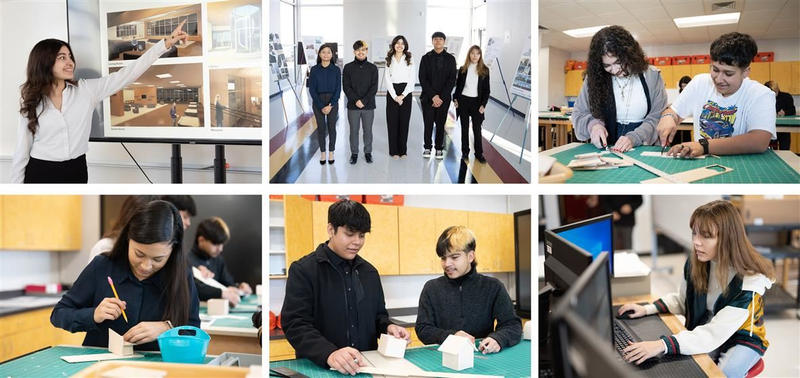
For a second consecutive year, a team of students from the El Dorado High School Aztec Architecture Academy won first place among school districts across Texas in the Texas Society of Architects’ (TxA) 2022 Student Design Challenge.
The academy’s aspiring architects showcased their talent by designing sustainable architecture that connected people to nature and reduced their environmental impact.
Ari Chavez, Natalie Herrera, Juan Ramirez and Dania Torres took first place for their project Desert Willow, a community recreational center designed to reduce the environmental footprint of border crosses into the United States at the Zaragoza International Bridge in El Paso's Lower Valley.
El Dorado senior Jazlyne Spreitzer’s entry titled Poseidon’s Grove won second place in TxA’s individual competition.
“This is one of my favorite competitions because it allows (students) to see the design process from the schematic going to design development,” said Luisa Valenzuela, Aztec Architecture Academy instructor. “It helps (them) also work as a group and see the level (of work) that they have to submit to actually compete with industry level, so that's the cool part of it.”
The Aztec Architectural Academy, the only one of its kind in the El Paso region, is a rigorous, hands-on program that allows students to gain a foundation in the fields of interior design, construction, civil engineering, and architecture. In 2021, two teams from the academy earned first and second place in the competition.
This year’s design challenge called for middle and high school students to find creative design solutions that go beyond the boundaries of architecture to address the challenge’s theme of CONNECTION: DESIGN + NATURE.
Spreitzer, who plans to study architecture at Texas Tech University next year, jumped at the chance to create a structure that would simultaneously benefit people and the environment.
She designed a residential community splash pad with hypoallergenic plants, accessible features for persons with disabilities, and spray misters that conserve water. To make the facility energy efficient, Spreitzer created a passive solar design that would use the sun's energy to heat and cool living spaces.
“I would love if it got implemented,” Spreitzer said. “I designed it to where it could be used in multiple locations, not just one set lot. And I hope something like this would be able to (be implemented in) the future.”
With thousands of people crossing into El Paso from Ciudad Juárez daily, Natalie Herrera and her teammates designed a recreational center adjacent to the Zaragoza International Bridge where pedestrians who cross the bridge can rest and wait for their transportation to arrive.
The site featured four environmentally friendly buildings with a food court, computer lab, and exterior and interior green spaces. It also included an underground museum, where people could learn how to lower their energy emissions.
Herrera said the competition offered her an opportunity to get hands-on architectural experience, which will help her when she attends college next year and when she competes for jobs as a professional architect.
“This benefits us a lot because in a professional architectural world there is a lot of competition, and that’s how you get these jobs,” Herrera said. “You have to compete in these competitions, so it just gets us ready.”
Published December 26, 2022
Strategic Direction: College and Career Readiness

